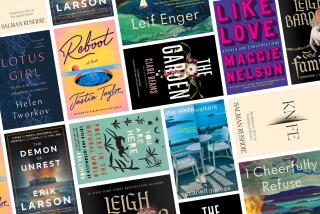“The Age of Comfort: When Paris Discovered Casual -- and the Modern Home Began” by Joan DeJean
The Age of Comfort
When Paris Discovered Casual -- and the Modern Home Began
Joan DeJean
Bloomsbury: 296 pp., $28
So many of the things we takes for granted in our homes -- comfortable armchairs and sofas, flush toilets, separate rooms and privacy -- came into being in France from 1670 to 1765, the period author Joan DeJean calls “The Age of Comfort.” With these changes came a new way of being at home; people began to wear more loose-fitting clothing; reclined in ways that would have been impossible on strict wooden furniture. The idea of a private bath attached to the bedroom was born in this period, as was the idea of the luxurious bath. Prior to the 17th century, status was asserted in grand facades and showy, gilded furniture. Practicalities like lighting, heating and storage were rarely considered. In this fascinating and carefully researched volume (reminiscent of Fernand Braudel’s “The Structures of Everyday Life”) DeJean considers the evolution of each room in the modern home. She looks at the effects of new objects on body language, family configurations and the larger community. This way of looking at history, moving outward from the particulars of everyday life, is particularly thrilling.
Cherries in Winter
My Family’s Recipe for Hope
in Hard Times
Suzan Colón
Doubleday: 256 pp., $21.95
“Being in this recession,” writes Suzan Colón, “feels like watching a nature film about the disintegration of a major polar ice shelf: huge chunks of everything we thought was solid keep breaking apart and disappearing into an abyss, the depth of which no one knows.” When Colón lost her job as a writer at a national magazine, she did what her family had done for generations: put up soup. She had more time to talk with her mother about the lives and favorite recipes of her foremothers. She thought about the fact that they had survived economic depressions and hard times. “When in doubt, bake,” she writes. Her grandmother baked to cheer herself up and to keep her house warm. She learned how to be grateful for things she had taken for granted: time, her husband’s support. The recipes are, shall we say, not bourgeois (Rigatoni Disoccupati -- Pasta of the Unemployed -- and Hot Dog Soup, to name a few). Colón’s mother remembers when her grandmother bought expensive cherries in the middle of a New York winter. She understood “the importance of a dark red cherry in the middle of winter: the snap of the skin, the tart juice tasting of summers past and the summer to come.”
Beauty and the Soul
The Extraordinary Power of
Everyday Beauty to Heal Your Life
Piero Ferrucci,
Translated from the Italian by
Vivien Reid Ferrucci
Tarcher/Penguin: 272 pp., $23.95
How do our lives change when we are open to beauty? This is the central question in Piero Ferrucci’s gentle book. We race around; harried, worried, distracted. Much of the time we are unable to see the beauty all around us. Some of us think we don’t deserve it or that it’s frivolous. When we work to change this, he writes, we escape from the cages we have created. We heal better when we are open to beauty, when healing is unobstructed by stress: “The encounter with beauty takes us easily back to the pure spring of our spontaneous emotional life.” Because beauty is temporary, he writes, appreciating it involves a kind of surrender. We must learn “to welcome it when it comes, let it go when it leaves.” Ferrucci’s writing is calm and clear. His insights are widely intuitive. The very act of reading his balanced sentences unties knots and encourages openness.
More to Read
The biggest entertainment stories
Get our big stories about Hollywood, film, television, music, arts, culture and more right in your inbox as soon as they publish.
You may occasionally receive promotional content from the Los Angeles Times.










